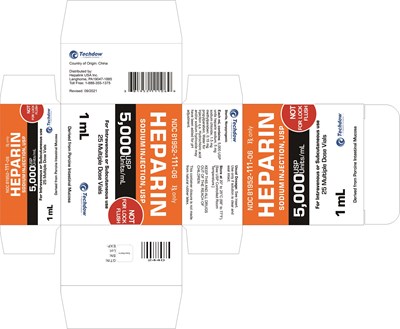Product Images Heparin Sodium
View Photos of Packaging, Labels & Appearance
Product Label Images
The following 13 images provide visual information about the product associated with Heparin Sodium NDC 81952-115 by Hepalink Usa Inc., such as packaging, labeling, and the appearance of the drug itself. This resource could be helpful for medical professionals, pharmacists, and patients seeking to verify medication information and ensure they have the correct product.
heparin-fig1 - heparin fig1

This is a description of a medical product derived from porcine intestinal mucosa. It is sterile, non-pyrogenic, and can be stored at a temperature range of 20-25°C. It can be administered through intravenous or subcutaneous route using a multiple dose vial. The manufacturer for the product is Hepalink USA Inc. and it expires on a date not specified in the provided text.*
heparin fig10

This is a description for a medication called Heparin Sodium Injection, USP. It is a sterile and non-pyrogenic solution that is used for intravenous or subcutaneous use. The solution contains 10,000 USP units of Heparin Sodium, 1.5 mg of methylparaben, and 0.15 mg of propylparaben. The container closure is not made of natural rubber latex. The medication is used as a lock flush and it should be used only if the solution is clear and the seal is intact. The usual dosage should be seen in the insert. The medication should be kept out of the reach of children and it should be stored at 20° to 25°C. Heparin Sodium Injection, USP is distributed by Hepalink USA Inc. and it is derived from Porcine Intestinal Mucosa.*
heparin fig11

This is a product information sheet for a sterile sodium injection made from porcine intestinal mucosa. The product is non-pyrogenic and can be stored at room temperature. It is manufactured in China and sold in the US by Hepalink USA Inc. The injection is intended for IV or SC use, with instructions to not use for lock flush. The product comes in a multiple dose vial with an expiration date of 05/2022.*
heparin fig12

This is a description of Heparin Sodium Injection, a drug packaged in a multiple-dose vial with a volume of 1 mL. It is derived from Porcine Intestinal Mucosa and contains 20,000 USP units heparin sodium, methylparaben, propylparaben, and water for injection. Its usage is for Intravenous or Subcutaneous administration. The drug is sterile, nonpyrogenic, and should be stored at room temperature. No natural rubber latex is utilized in the packaging. Information about the manufacturer, origin, and revised date are also provided. Dosage should be determined by the instructions given in the insert.*
heparin-fig2 - heparin fig2

This is a pharmaceutical product called Heparin Sodium Injection, USP. It contains heparin sodium, sodium chloride, methylparaben, propylparaben, and water for injection. The dosage information is available in a separate insert. The solution is sterile, nonpyrogenic, and derived from porcine intestinal mucosa. The container is latex-free. It is for intravenous or subcutaneous use. Keep this and all drugs out of the reach of children. Store between 20°C and 25°C. Distributed by Hepalink USA Inc. from China. Revised in September 2021. The remaining text is unreadable.*
heparin fig3

This appears to be a product description for a sterile, non-pyrogenic medical solution derived from porcine intestinal mucosa. It comes in a single-dose vial and should be stored at temperatures ranging from 20 to 1025 degrees Celsius. The label includes information about the manufacturer and expiration date, and instructs users to discard any unused portion of the solution.*
heparin fig5

This is a description of a pharmaceutical product that contains Heparin. The product is called "Beonly L" and is a sterile solution derived from the porcine intestinal mucosa. It comes in a multiple dose vial of 1ml and is intended for IV or SC use only. The solution is not for lock flush purposes. The NDC code for this product is 81952-112-01, and it should be stored at 20°C. The lot and expiration dates are missing from the available text.*
heparin fig7

NDC 81952-112-04 is a medication called HEPARIN SODIUM INJECTION. It comes in a 10 mL Multiple Dose Vial, with each mL containing 1000 USP Units of the medication. The medication is not to be used for lock flush and is meant to be administered IV or SC. The medication is derived from Porcine Intestinal Mucosa and is sterile, nonpyrogenic. The vial should be stored at 20° to 25°C (68" to 77°F). The manufacture of this medication is from China for Hepalink USA Inc. The lot information and expiration date is provided.*
heparin fig8

This is a description for a heparin sodium injection, USP used for Intravenous or Subcutaneous use that has been made isotonic with sodium hydroxide or glycine. It is sterile, nonpyrogenic and has a clear seal for protection. The vial has been distributed by Techdow while the country of origin is China. This container closure is not made from natural rubber latex. The contact information of Hepalink USA Inc. is provided along with the manufacturing date to be November 2021. There are also storage directions provided along with a warning to keep it out of reach of children. There are other texts such as NDC 81952-112-09 B, not sure what it refers to.*
heparin fig9

This is a description of a Sodium Injection that is derived from Porcine intestinal mucosa. It is sterile, non-pyrogenic and should be stored at a temperature between 20°C to 25°C. The injection is manufactured in China by Hepalink USA Inc. and comes in a multiple-dose vial, which needs to be used for IV or SC use before the expiration date mentioned on the vial. The text also mentions that it is not for Logk flush.*
* The product label images have been analyzed using a combination of traditional computing and machine learning techniques. It should be noted that the descriptions provided may not be entirely accurate as they are experimental in nature. Use the information in this page at your own discretion and risk.


